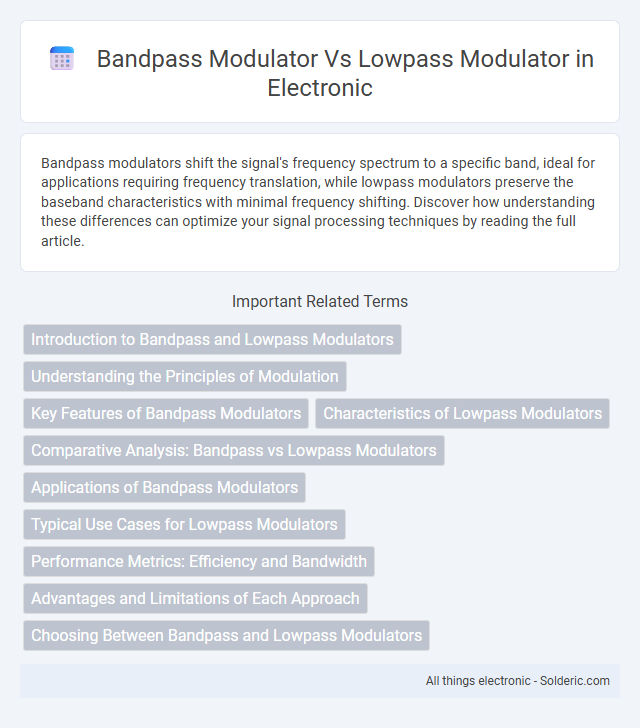Bandpass modulators shift the signal's frequency spectrum to a specific band, ideal for applications requiring frequency translation, while lowpass modulators preserve the baseband characteristics with minimal frequency shifting. Discover how understanding these differences can optimize your signal processing techniques by reading the full article.
Comparison Table
| Feature | Bandpass Modulator | Lowpass Modulator |
|---|---|---|
| Frequency Range | Passes a specific band of frequencies | Passes frequencies from 0 Hz up to a cutoff |
| Application | Used in RF communication, band-limited signals | Used in baseband signals, audio processing |
| Signal Processing | Modulates signals centered around a carrier frequency | Modulates signals with frequencies near zero |
| Complexity | Higher complexity due to band selection and carrier frequency | Simpler design, easier implementation |
| Noise Immunity | More selective, reduces out-of-band noise | Less selective, may pass unwanted low-frequency noise |
| Examples | Amplitude Modulation (AM), Frequency Modulation (FM) | Pulsed Modulation, Delta-Sigma Modulator |
Introduction to Bandpass and Lowpass Modulators
Bandpass modulators filter signals within a specific frequency range, allowing only frequencies between a lower and upper cutoff to pass, making them ideal for applications like wireless communication where narrow bandwidths are essential. Lowpass modulators, on the other hand, permit signals from zero frequency up to a defined cutoff, effectively attenuating higher frequencies, which suits baseband signal processing and audio transmission. Understanding the frequency response characteristics of bandpass and lowpass modulators is crucial for selecting the appropriate modulation technique in communication system design.
Understanding the Principles of Modulation
Bandpass modulators operate by shifting the baseband signal to a specific carrier frequency, enabling efficient transmission over a designated frequency band while minimizing interference. Lowpass modulators, in contrast, modulate signals at baseband or near-zero frequencies, focusing on bandwidth-limited transmission without frequency translation. Understanding these modulation principles is crucial for optimizing signal fidelity and spectral efficiency in communication systems.
Key Features of Bandpass Modulators
Bandpass modulators offer the distinct ability to selectively transmit signals within a specific frequency band, enhancing signal clarity and reducing interference compared to lowpass modulators which allow a wider range of lower frequencies. Their key features include high frequency selectivity, improved noise rejection, and efficient bandwidth utilization, making them ideal for applications requiring precise frequency targeting such as RF communication systems. Your choice of a bandpass modulator ensures optimal performance in environments where signal integrity and frequency discrimination are critical.
Characteristics of Lowpass Modulators
Lowpass modulators are characterized by their ability to filter out high-frequency components, allowing only signals within a desired low-frequency range to pass through. They are commonly used in applications requiring noise reduction and signal clarity in the baseband frequency spectrum, providing a clean, stable output. Your system benefits from these modulators when precise low-frequency signal processing and minimized distortion are crucial.
Comparative Analysis: Bandpass vs Lowpass Modulators
Bandpass modulators target a specific frequency range, allowing efficient transmission of signals within that band while minimizing noise outside it, making them ideal for applications like RF communication. Lowpass modulators, in contrast, transmit signals up to a cutoff frequency, offering broader bandwidth but higher susceptibility to out-of-band interference and noise. Your choice between bandpass and lowpass modulators should consider the required signal bandwidth, noise environment, and system complexity to optimize performance.
Applications of Bandpass Modulators
Bandpass modulators are essential in wireless communication systems, where they enable efficient transmission and reception of RF signals within specific frequency bands, minimizing interference and signal distortion. They are widely used in applications such as radar systems, satellite communications, and mobile networks to modulate carrier frequencies precisely. Your choice of a bandpass modulator ensures improved spectral efficiency and signal clarity in high-frequency environments compared to lowpass modulators.
Typical Use Cases for Lowpass Modulators
Lowpass modulators are commonly employed in baseband communication systems where signal frequency components are confined within a narrow band around zero frequency, such as in wired audio transmission and digital baseband filtering. These modulators excel in scenarios requiring efficient rejection of high-frequency noise, enabling accurate signal recovery in applications like Ethernet communication and low-frequency sensor data transmission. Their simplicity and effectiveness make them ideal for processing signals with bandwidths significantly lower than the carrier frequency.
Performance Metrics: Efficiency and Bandwidth
Bandpass modulators offer improved spectral efficiency by concentrating the signal within a specific frequency band, reducing out-of-band emissions and maximizing available bandwidth usage. Lowpass modulators, while simpler, often utilize a broader frequency range, which can lead to higher noise and less efficient bandwidth utilization. Optimizing Your system involves balancing these performance metrics to achieve desired efficiency and bandwidth constraints based on application needs.
Advantages and Limitations of Each Approach
Bandpass modulators offer the advantage of directly targeting specific frequency bands, reducing the need for additional filtering and improving spectral efficiency in narrowband communication systems. Lowpass modulators simplify design and are effective for baseband signals, but they require extra filtering stages to handle high-frequency components and prevent aliasing in wideband applications. Your choice depends on the application's frequency requirements and system complexity, with bandpass modulators excelling in RF scenarios and lowpass modulators suited for baseband processing.
Choosing Between Bandpass and Lowpass Modulators
Choosing between bandpass and lowpass modulators depends primarily on the specific frequency ranges required for your application. Bandpass modulators excel in filtering and modulating signals within a narrow, defined frequency band, making them ideal for wireless communication systems and radar applications. Lowpass modulators, on the other hand, are suited for baseband signal processing by passing frequencies below a cutoff point, commonly used in audio processing and data conversion systems.
Bandpass modulator vs lowpass modulator Infographic

 solderic.com
solderic.com